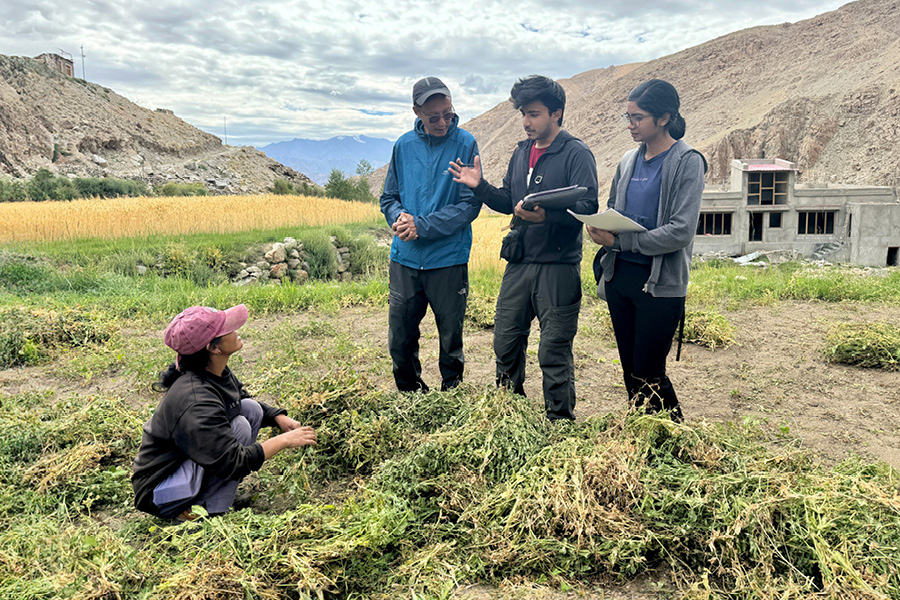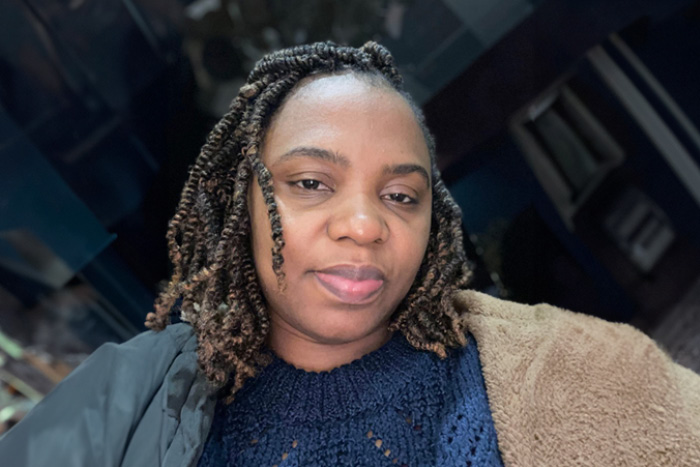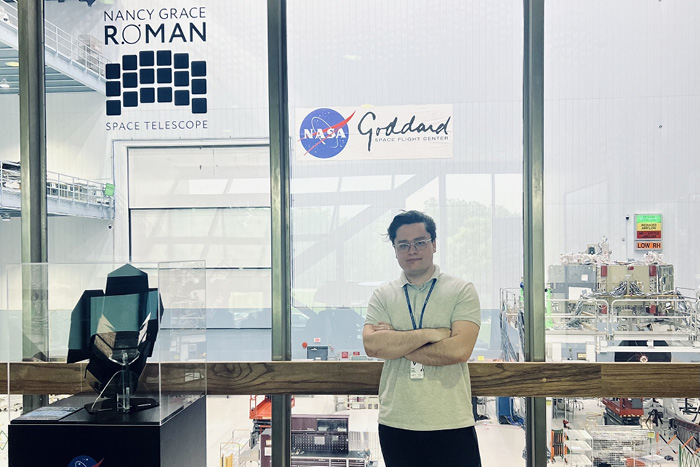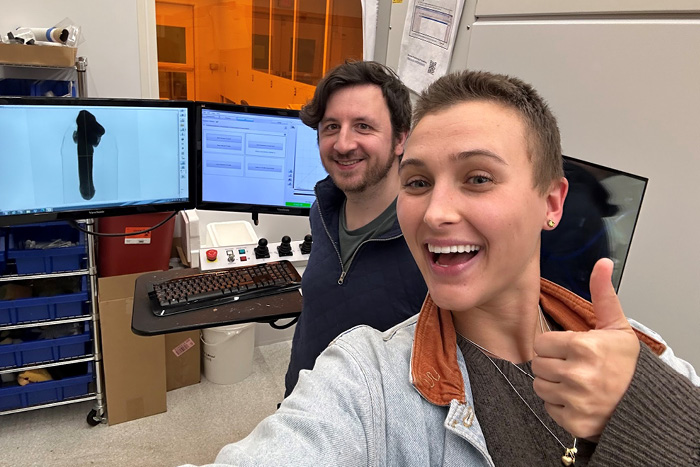Tech
Guiliano Global Fellows: Glacier Saviors, Exoplanets, and More

Pictured: Dev Sharma (standing, middle) and Dolly Shyam (right) interviewed farmers to gain insight into the impact of artificial glaciers in the local village, located at an altitude of 13,000 feet in the northwestern Himalayas.
Since the Edward Guiliano Global Fellowship Program’s inception in 2014, more than 200 New York Tech students have participated in experiential-based learning opportunities across the United States and in countries like Costa Rica, Mongolia, Canada, Eswatini, and more. For the last 10 years, the fellowship has enabled these young scholars to take high-level research trips, linking their academic studies with a broader perspective of the world around them.
The most recent cohort journeyed at least 200 miles from their home or New York Tech campus—staying as “local” as Maryland and trekking as far as India—and were supported with monetary amounts between $750 and $5,000.
One student, Navjot Guru, has yet to complete his research trip, but New York Tech News caught up with a few who have returned to learn about their transformative experiences.
Historic Medicine
Noah Hoonhout fused his passions for history and medicine with his research at the Royal College of Surgeons of England and at Kings College London.
Osteopathic medicine student Noah Hoonhout has a bachelor’s degree in history, so it is fitting that with his $2,750 in fellowship funding he would travel to London to complete his project “The Romantic Medicine of Joseph Henry Green.”
For one week in July, Hoonhout performed research within the archives of the Royal College of Surgeons of England and at Kings College London, studying 19th-century English physician Joseph Henry Green. With great interest in the history of medicine, Hoonhout sought to examine Green’s contributions at the intersection of the humanities and medicine.
Through reading the physician’s books, essays, and letters, he learned of Green’s biography, academic interests, and career achievements, including an assortment of philosophical work—which may have influenced the medical field at the time. Reading Green’s debates about human anatomy, evolution, medical reform, and philosophy showed Hoonhout how past physicians viewed the medical profession; his own desire to pursue medicine has only been reaffirmed as he synthesizes his research discoveries. “This research trip was like a gateway into the academic world of the history of medicine,” Hoonhout says. “I am very grateful for the fellowship program giving me this opportunity.”
Himalayan Glacier Saviors

Laetitia Mouafo served as her team’s data scientist in analyzing glacier activity in the Himalayas in Leh, Ladakh, India.
With a shared passion for climate change and sustainability, graduate data science students Laetitia Mouafo, Dev Sharma, and Dolly Shyam received a total of $11,745 to support their travel to Leh, Ladakh, India, where they collaborated with local communities for their research project, “Leveraging Data Science to Mitigate Glacier Melting in the Himalayas.”
Located on the northwestern end of the Himalayas, Ladakh is known for its cold desert climate, minimal precipitation, and heavy reliance on glacial meltwater for agriculture. But climate change has caused a rapid retreat of glaciers, creating water scarcity and threatening agricultural livelihood, explains Sharma, who served as the team’s climate scientist. To counteract these effects, Ladakh locals have developed artificial glaciers, or “ice stupas.” These conical structures use remote sensing technologies and ground surveys to store water during the winter and gradually release it during warmer months, ensuring a sustained water supply for irrigation during the pre-sowing period.
On-site, the trio’s research involved gathering and analyzing datasets related to glacier characteristics, climate patterns, and environmental factors contributing to melting. Mouafo, the team’s data scientist, says the group used advanced data analysis and machine learning algorithms to identify key drivers of glacier melting, predict future trends, and explore potential solutions, such as improved water resource management and sustainable land use practices. The team provided actionable recommendations to policymakers and local communities to help mitigate the impacts of glacier melting and ensure the long-term sustainability of the Himalayan ecosystem.
“This experience was transformative,” says Shyam, the team’s stakeholder engagement specialist. “The insights we gained will undoubtedly shape our futures in climate adaptation and sustainability.”
Searching for Exoplanets

Avery Gilson spent 10 days at NASA’s Goddard Space Flight Center in Greenbelt, Md.
When Avery Gilson was just 15 years old, he read a book on string theory, general relativity, and quantum mechanics, and by his senior year of high school he began working as a production manager at his father’s robotics company. With $2,208 in support, Gilson, now a physics student, had the chance to take his passions a step further as he spent 10 days in August at NASA’s Goddard Space Flight Center in Greenbelt, Md., where he pursued his project, “Research on Polarization Aberrations at NASA’s Goddard Space Flight Center.”
At the Center, Gilson worked with Optical Engineer Breann Sitarski, Ph.D., in support of the Habitable Worlds Observatory (HWO)—the first telescope designed specifically to search for signs of life on planets orbiting other stars. For his research, Gilson mathematically modeled polarization aberrations in the primary mirror of a telescope. He explains that in the search for habitable exoplanets, it is essential to block extremely bright stars and observe faint reflections from exoplanets, which requires high-contrast stability maintained for long periods of time, advanced optics, and precise control.
A research assistant with Professor of Physics Ben Ovryn, Ph.D., Gilson is familiar with the intricacies of sophisticated optical instruments and excelled in his work with Sitarski. Back on campus, he plans to experimentally verify several of his NASA calculations in Ovryn’s lab using NASA-provided optical coatings. Ovryn and Sitarski now have a two-year grant from NASA to work on optical engineering challenges associated with the HWO.
“As an experimental scientist with a love for optical physics, this project was a dream come true,” Gilson says. “I am tremendously thankful that the fellowship provided an opportunity for me to work at NASA.”
Monkey Muscles

Aleksandra Ratkiewicz performed research at Duke University with postdoctoral research scholar Edwin Dickinson, Ph.D.
For the past two years, osteopathic medicine/academic medicine (D.O./M.S.) student Aleksandra Ratkiewicz has been working on a project under the guidance of Assistant Professor of Anatomy Michael Granatosky, Ph.D., to develop and apply a standardized and automated workflow for studying muscle tissues. The process uses textural recognition algorithms to track individual muscle fascicles in 3-D. Ratkiewicz now seeks to conduct side-by-side comparisons of gross anatomy dissection and digital dissections across the hindlimbs of long-tailed macaques.
In pursuit of the research project, “Developing Algorithmic Techniques for the Tomographic Study of Skeletal Muscle,” and on a mission to obtain the best quality scans for optimal sample processing potential, Ratkiewicz received $5,000 in fellowship funding to split time between Duke University in Durham, N.C., and London.
At Duke, Ratkiewicz spent five days with postdoctoral research scholar Edwin Dickinson, Ph.D., using the university’s powerful, high-resolution Nikon XT H 225 ST micro-CT scanner to scan macaque specimens—a critical step forward in validating the automated digital reconstruction method they are developing. Ratkiewicz then spent the summer analyzing the scans and creating digital reconstructions of the musculature, and on September 9, presented at the three-day Tomography for Scientific Advancement (ToScA) UK & Europe Symposium.
As the data collection continues, Ratkiewicz is gaining much insight into how well gross dissection compares to digital dissection, as well as how valid the algorithmic method is. Additionally, Ratkiewicz has gained a new sense of confidence and independence as a scientist. “This fellowship is a gamechanger in terms of funding and flexibility,” Ratkiewicz says. “I am beyond honored to be chosen and extremely grateful for the provided opportunities. My project would not be possible without this fellowship.”
Future Projects
Navjot Guru, an osteopathic medicine/medical and biological sciences (D.O./Ph.D.) student, will complete his project in December when he travels to Singapore for his research, “Advancing Research Horizons: Sharing Findings and Fostering Collaboration Through Conference and Lab Visit.”
Students are selected for the Edward Guiliano Global Fellowship Program based on their applications, including the following metrics: the project’s purpose, goals, and methods; creativity; transformative potential; intended effect; and budget proposal.
The next cohort of selected students will complete their travels during winter 2024 and spring 2025. Interested students may submit their project proposal by November 8.










